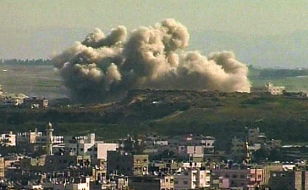AI: Israel Used Phosphorus Bombs in Gaza

Some phosphorus still burning
Amnesty International’s delegates found still-burning white phosphorus wedges
all around residential buildings on Sunday. These wedges were further
endangering the residents and their property; streets and alleys are full of
children playing, drawn to the detritus of war and often unaware of the danger.
The carrier shells which delivered the wedges were also still lying in and
around houses and buildings. Some of these heavy steel 155mm shells have caused
extensive damage to residential properties.
"Yesterday, we saw streets and alleyways littered with evidence of the use
of white phosphorus, including still burning wedges and the remnants of the
shells and canisters fired by the Israeli army," said Christopher Cobb-Smith,
a weapons expert who is in Gaza as part of the four-person Amnesty
International team.
"A war crime"
"White phosphorus is a weapon intended to provide a smokescreen for troop
movements on the battlefield," said Cobb-Smith. "It is highly
incendiary, air burst and its spread effect is such that it that should never
be used on civilian areas.”
Donatella Rovera, Amnesty’s researcher on Israel
and the Occupied Palestinian
Territories said that such extensive
use of this weapon in Gaza's
densely populated residential neighbourhoods is inherently indiscriminate.
"Its repeated use in this manner, despite evidence of its indiscriminate
effects and its toll on civilians, is a war crime," she said.
Many civilians affected
When each 155mm artillery shell bursts, it deploys 116 wedges impregnated with white phosphorus which ignite on contact with oxygen and can scatter, depending on the height at which it is burst (and wind conditions), over an area at least the size of a football pitch. In addition to the indiscriminate effect of air-bursting such a weapon, firing such shells as artillery exacerbates the likelihood that civilians will be affected.
"Artillery is an area weapon; not good for pinpoint targeting. The fact that these munitions, which are usually used as ground burst, were fired as air bursts increases the likely size of the danger area,” said Chris Cobb-Smith.
Attack on UNRWA compound and hospital
Among the places worst affected by the use of white phosphorus was the UNRWA compound in Gaza City, at which Israeli forces fired three white phosphorus shells on 15 January. The white phosphorus landed next to some fuel trucks and caused a large fire which destroyed tons of humanitarian aid.
Prior to this strike, the compound had already been hit an hour earlier and the Israeli authorities had been informed by UNRWA officials and had given assurance that no further strikes would be launched on the compound.
In another incident on the same day a white phosphorus shell landed in the al-Quds hospital in Gaza City also causing a fire that forced hospital staff to evacuate the patients.
Withdrawal lets horrors emerge
The Israeli army has now announced its complete withdrawal from the Gaza Strip. However, units are waiting on the Israeli border, and navy ships are anchored on the shore of Gaza.
UN General Secretary Ban Ki-moon visited the Gaza area and was horrified at the damage. He has called for an investigation.
Ban also visited Sderot city in Israel. He condemned the Hamas missile attacks there as violating basic human rights.
Attacks since 27 December
On 18 January, Israel and Hamas announced separate ceasefires.The Israeli attacks had started on 27 December with air attacks and continued with ground operations from 3 January. More than 1,300 Palestinians, a third of them children, died in Gaza, and, according to Palestinian authorities, 5,500 people were wounded. The Israeli army says that 13 Israelis, 3 of them civilians, were killed.
"No winners"
UN aid worker John Holmes said, “No one knows who won this battle, but it is clear that the people of Gaza were the losers.”
In the region, where 1.4 million people live, some neighbourhoods have been totally destroyed. More than 4,000 houses have collapsed, and around 20,000 are severely damaged. Rebuilding Gaza, so Holmes, will cost billions of dollars.
The Palestine Statistics Centre confirmed these numbers on 19 January, saying that 4,100 homes have been destroyed completely, and that 17,000 are severely damaged.
According to the centre, 1,500 factories and workplaces, 20 mosques, 31 security buildings and 10 water and canalisation pipelines have been damaged. It estimates the material damage at 1.9 billion dollars.
Still great dangers and difficulties
Holmes added that sewage is flowing in the streets, that there is a great lack of medicine and food, and that unexploded ammunition represents a great danger. Although 100,000 people gained access to water again after 18 January, there are still 400,000 people without water.
The UN worker said that electricity is limited to less than 12 hours a day, and that 100,000 people have been displaced.
Arab World not united
Meanwhile the Arab Union meeting of ministers of foreign affairs organised by Kuwait has not reached any final decision.
While a message of support of the Palestinian people was read in the concluding statement, no concrete steps were mentioned.The question as to who was responsible for Israel’s attack was left to the state and government ministers.
An attempt to create a financial aid fund for Gaza was not successful. While Saudi Arabia and Egypt had pledged 1 billion dollars in aid previously, their leaders did not attend the last session of the summit. (TK/AG)
* The first part of the article was taken from www.amnesty.org. Subheadings were added.










